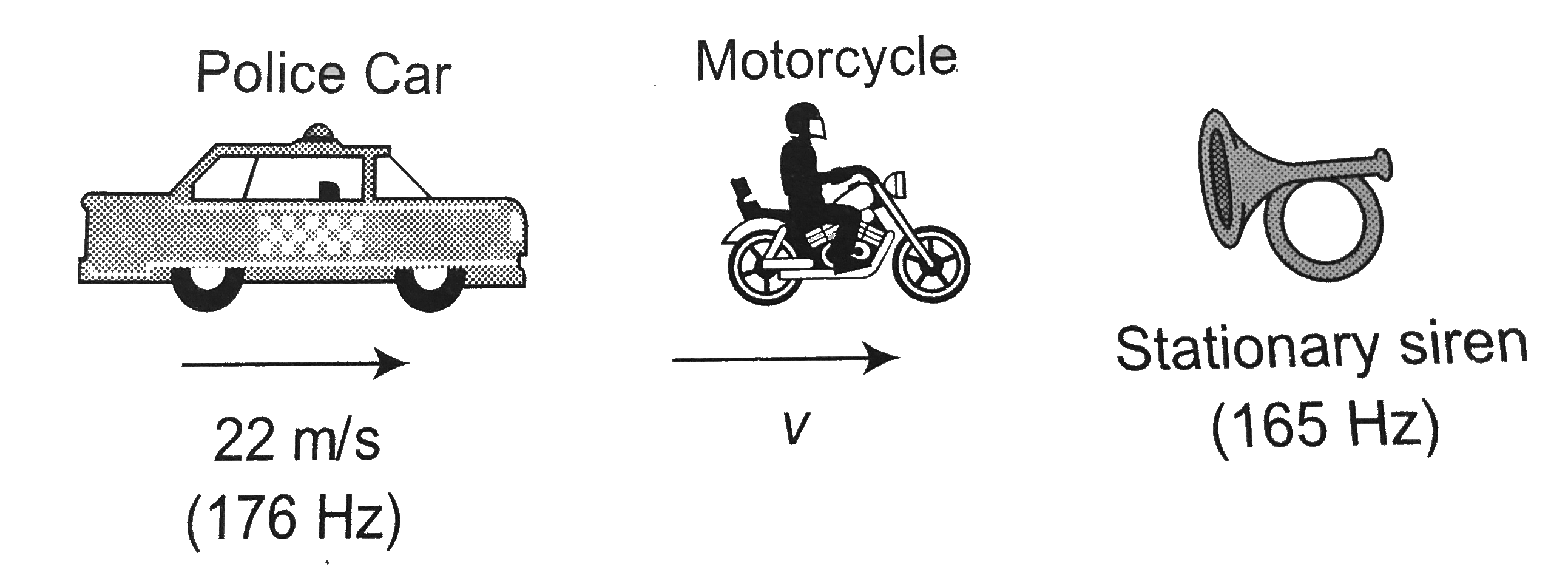A police car moving at 22m/s, chase a motoclist. The police man has horn at 176HZ, While both of them move towards a stationary siran of frequency 165HZ. Calulate the speed of the motorcyclist, if he does not observer any beats. (velocity of sound in air =330m/s)

33 m/s
22 m/s
zero
11 m/s
The correct Answer is:B
The motorcyclist observes no beats. So the apparent frequency observed by him from the sources must be equal.
f1=Frequency recorded by motorcyclist from police car.
f2=Frequency recored by motorcyclist from stationary siren.
∴176(330−υ330−22)=165(330+υ330)
Solving this equation we get, υ=22m/s
Topper's Solved these Questions
- BOOK - RESONANCE ENGLISHCHAPTER - SOUND WAVESEXERCISE - Solved Examples24videos
SOUND WAVES
- BOOK - RESONANCE ENGLISHCHAPTER - SOUND WAVESEXERCISE - Board Level Exercise33videos
SOUND WAVES
- BOOK - RESONANCE ENGLISHCHAPTER - SIMPLE HARMONIC MOTIONEXERCISE - Exercise28videos
SIMPLE HARMONIC MOTION
- BOOK - RESONANCE ENGLISHCHAPTER - STRING WAVESEXERCISE - Exercise32videos
STRING WAVES
Similar Questions

A police car moving at 22m/s, chases a motorcyclist, the police man sounds his horn at 176Hz, while both of them move towards a stationary siren of frequency 165Hz. Calculate the speed of the motorcycle, if it is given that he does not observes any beatView SolutionA police car moving at 22ms−1 chases a motor cyclist. The police man sounds horn at 176 Hz. While both of them move towards a stationary siren of frequency 165 Hz. If the number of beats heard by the motor cyclist per second is zero, then the speed of motorcycle is (Speed of sound in air =330ms−1)
View SolutionA police car moving at 30 m s−1, chases a motorcyclist. The policeman sounds his horn at 180 Hz, while both of them move towards a stationary siren of frequency 160 HZ. He does not observe any beats then, calculate the speed (in m s−1) of the motorcyclist round off two decimal places? [speed of sound =330ms−1]
View SolutionTwo tuning forks with natural frequencies 340HZ each move relative to a stationary observer . One forks moves away from the oberver while the other moves towards him at the same speed . The observer hears beats of frequency 3HZ . Find the speed the of the tuning fork (velocity of sound in air is 340m/s) .
View SolutionThe ratio of the apparent frequencies of a car when approaching and receding a stationary observer is 11:9 What is the speed of the car, if the velocity of sound in air is 330 m/s?
View Solutiona bus is moving towards and stationary observer with speed 20 m/s blows a horn of frequency 200 Hz. the frequency of sound heard by the observer is approximately ( take speed of sound 320 m/s)
View SolutionBus moving with speed v forwards a stationary wall. it produces sound of frequency f=420Hz.Theheardequencyofref≤ctedsoundomwallbydriveris490 Hz.Calca––tethespeedvofbus.Thevelocityofsound∈airis330 m/s.
View SolutionA person is riding a motorcycle at a speed v towards a stationary car operating its siren at 165Hz. A police car is chasing the person at a speed 22 m/s with its siren operating at 176 Hz. If the motorcyclist does not heard beats, the speed v (m/s) is (speed of sound in air = 330 m/s)
View SolutionA whistle giving out 450HZ approaches a stationary observer at a speed of 33m/s. The frequency heard the observer (in HZ) is (speed of sound =330m/s)
View SolutionA whistle giving out 450HZ approaches a stationary observer at a speed of 33m/s. The frequency heard the observer (in HZ) is (speed of sound =330m/s)
View Solution

